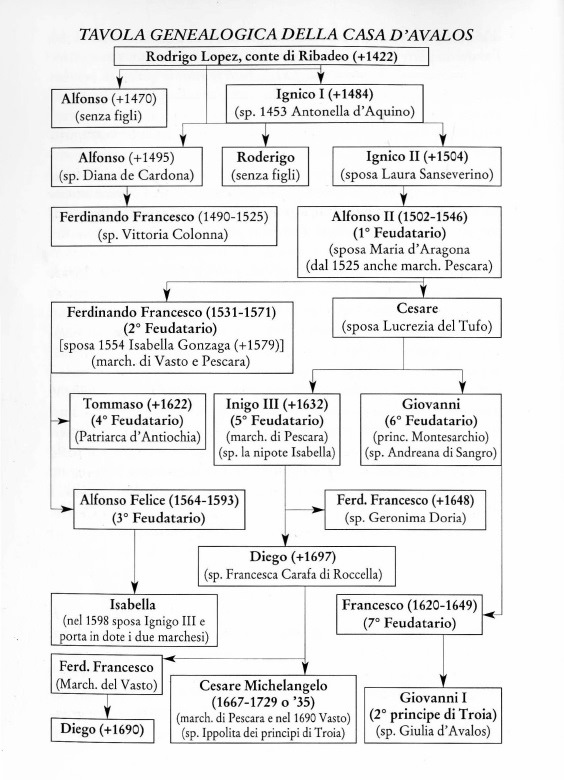The D’Avalos family, likely of Visigothic origin, arrived in Italy as part of Alfonso I of Aragon’s entourage. They distinguished themselves through military prowess, diplomatic skill, and loyalty to the Crown—qualities that ensured they maintained a prominent role in both Italian and European politics of the time.
The brothers Innico, Alfonso, and Rodrigo, sons of Ruy López Dávalos, came to Italy with King Alfonso V of Aragon, who ascended the throne of Naples in 1442.
Innico Primo d’Avalos married Antonella d’Aquino, the last descendant of the d’Aquino family. Through this marriage, Innico gained the County of Monteodorisio and the Marquisate of Pescara. Their descendants adopted the surname d’Avalos d’Aquino.
Alfonso II d’Avalos, the eldest surviving son of the couple, inherited the title of Marquis of Pescara, while Innico II d’Avalos, the younger son, became the first Marquis of Vasto. In 1497, he received the Vasto fief, which had originally been granted by Alfonso d’Aragona in 1444 to Innico de Guevara, a member of a Spanish family closely related to the D’Avalos.
In the 16th century, the Marquises of Pescara played a central role in both the military and political history of Italy. Fernando Francesco, also known as Ferrante d’Avalos, was a key figure in the Battle of Pavia, where the forces of Charles V of Habsburg defeated and captured King Francis I of France. It was during this battle that Spanish dominance over Italy was solidified, and Ferrante was appointed Governor of Milan, a position he held for only a few days before dying in December 1525 from injuries sustained in the victorious battle.

Ferrante’s wife, Vittoria Colonna, daughter of the famous mercenary captain Fabrizio Colonna, also played an important historical role. After her husband’s death, Vittoria withdrew to the Aragonese Castle of Ischia, where she established the most renowned cultural circle of the time, gathering notable figures such as Michelangelo Buonarroti, Ludovico Ariosto and Jacopo Sannazaro, among others. Vittoria is remembered as a poet, and many works of art have been dedicated to her.
After Ferrante Francesco’s death, the title of Marquis of Pescara passed to his cousin, the only son of Innico II, Alfonso III d’Avalos, who had fought alongside Ferrante at Pavia. Alfonso III thus united the Marches of Vasto and Pescara and served as Governor of Milan from 1538 to 1546. His son, Francesco Ferdinando d’Avalos, held significant governmental positions, including Governor of the Duchy of Milan and Viceroy of Sicily. He also represented the Spanish crown at the Council of Trent, an appointment that earned him the relic of the Sacred Thorn, now venerated in Santa Maria Maggiore.
The main line of the family came to an end with Alfonso Felice d’Avalos, commander of the Spanish cavalry. Upon his death in 1593, the titles and estates of the primary branch of the family passed to Innico III d’Avalos.
From Innico III onward, Vasto became the center of the D’Avalos family’s holdings, serving as their capital in both artistic and urban terms.
Throughout the 17th century, various branches of the family held power, during a period when Vasto, like the rest of the Kingdom of Naples, suffered economically due to the decline in maritime trade. Nevertheless, churches and palaces continued to be constructed, shaping the town’s character to this day.
Among the key figures in the Baroque transformation of Vasto was Diego I d’Avalos, Marquis of Vasto until his death in 1697. He commissioned the construction and restoration of several places of worship and promoted the establishment of the Lucchese Fathers’ college. His son, Cesare Michelangelo d’Avalos, played a key role in Vasto being granted the coveted title of city, earning the town the nickname “Athens of the Abruzzi” for the grandeur with which the marquis surrounded his court.

